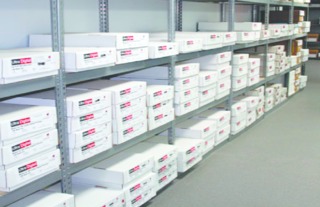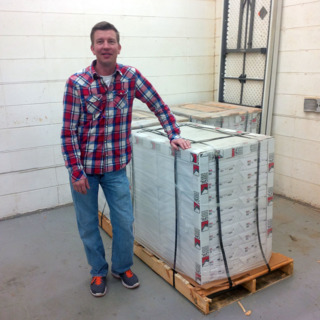Trends in Digital and Offset Papers: Serving Today’s "Just-In-Time" Market
While offset is still the dominant print platform for commercial applications, demand for digital printing continues to swell.

Walk into the production environment of any successful print service provider today and there’s a good chance you’ll see offset and digital presses working side by side.
While offset is still the dominant print platform for commercial applications, demand for digital printing continues to swell. Digital printing is projected to reach 19.1% of global print value by 2022, according to Smithers Pira research. Advances in digital press technology are fueling this trend, but that doesn’t mean a new generation of offset papers aren’t also leaving a mark on the industry.
According to John Crumbaugh, Industrial Inkjet Print Marketing Expert for HP, “Paper specifically designed for inkjet continues to expand into the high growth markets of direct mail, commercial, and publishing. There is growth in coated papers designed for inkjet, as well as silk/satin papers, and smooth high quality uncoated inkjet papers. This growth shows that the paper mills are focusing their efforts toward more graphic oriented print.”
Ron Pergande, Business Development Director of Digital Papers for GPA, Specialty Substrate Solutions, sees a number of trends ushering in the new era of print, including “premium brands not being requested by name like they used to, digital sheet sizes expanding in breadth and complexity, and caliper ranges growing to complement equipment capabilities.”
He adds that some of the hottest markets for PSPs this year include medical/pharmaceutical, banking/insurance, travel/hospitality, automotive, and fashion—while packaging and labeling markets present opportunities as well.
“As more traditional commercial printers expand into packaging and labeling markets, they are able to serve print buyers on more levels,” said Pergande, “There’s also a general shift from providing one type of printing service to becoming a total solutions provider, facilitating marketing success beyond print.”
Crumbaugh agrees, noting that PSPs are making inroads into packaging and labeling, but paper technologies from the packaging market are also influencing the world of publishing. “Everything from the fiber in the packaging industry to the technology going into packaging papers is impacting publishing—new things are being learned all the time,” he said.
PSPs are Raising the Bar
To be successful in these premium markets, said Pergande, PSPs need to up their game on all fronts.
“A PSP’s world is more complex, with higher expectations than ever before,” said Pergande. “Their customers continue to ask for speed, with many operating under the assumption that everyone is a quick printer. Customers are also asking for versatility, low costs, high quality (a given), and results. Brand owners continue to expect PSPs to produce ROI and increased market visibility with the marketing communications that they’re creating together.”
Crumbaugh emphasized that new printing and paper innovations are working together to help inkjet presses deliver the high-quality brands require.
“Now inkjet is no longer competing with toner, or competing for billing statements,” Crumbaugh said. “It is competing head to head with offset – and quality is hugely important. The printer has to produce quality, and agencies always have an opinion. They are very particular about paper.”
To that end, PSPs are calling on supply chains, including paper mills and other vendors for support.
“PSPs are asking that their vendors know their businesses inside and out, and that they also understand the complexity of how their world has changed so quickly – not just in papers,” said Pergande. “Coated and uncoated papers are still in highest demand, though PSPs are realizing that they can do more with the capabilities of their production environments. They are looking for ways to customize their internal inventory, and order on demand to accommodate their clients’ print-on-demand needs.”
Printing for a Just-In-Time World
To help PSPs compete in today’s print-on-demand economy, Pergande noted that “savvy merchants have accelerated their logistics and service to accommodate the rapid pace of digital printing,” and are delivering up to three times more a day than “the biggest printing consumers in most major markets.”
The bottom line is that any paper a PSP needs today “absolutely has to be available in whatever quantities are needed,” Pergande added. “It’s also expected to run on different platforms of printing presses: every sheet, every time, and without fail from production to finishing.”
This scenario is not always feasible with papers alone, but where priming and bonding agents come into play many PSPs require “both inkjet and offset versions to allow for a fluid movement of work across different presses,” according to Crumbaugh. “Where this is not available, priming and bonding agents keep paper from becoming an impediment to jobs being produced.”
“HP Bonding Agent and Primer enable printing to every category of paper to meet a customer’s needs. PSPs don’t necessarily get to pick the papers. Sometimes the agency specifies the media to be used. Having a bonding agent and primer enables PSPs to say ‘yes’ to more jobs,” Crumbaugh continued.
Paper Mills Are Onboard
According to Crumbaugh, all of these changing market conditions have paper mills taking note.
“Paper mills are all about massive tonnage,” he said. “As analog pages move to inkjet, it is not necessarily favorable to their business model, but they are adjusting.”
This is a positive trend for PSPs with digital presses.
“Inkjet is moving into the mainstream of printing, and competing with offset, and this makes it more relevant to the paper mills that service this wider market,” said Crumbaugh. “Inkjet brings many advantages over offset while also being complementary in some cases. Paper, or technologies that allow for papers to be printed, must be available so PSPs can move jobs through their businesses as efficiently as possible. With inkjet, that could mean a full variable job, a just-in-time, short-run job, or added capacity for jobs we don’t typically think of as inkjet work.”
Pergande added, “Print is expected to drive results for brands and direct mail campaigns, and also to complement digital marketing strategies. The factors driving the future of digital and offset papers include compatibility, availability, and seamless performance from print production through the marketplace.”

